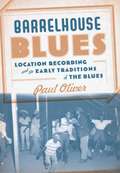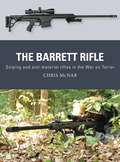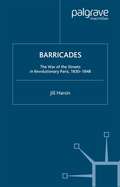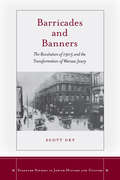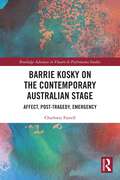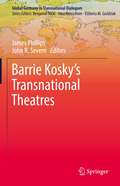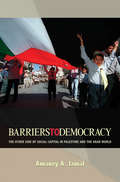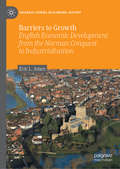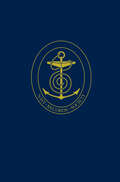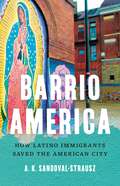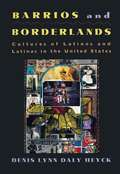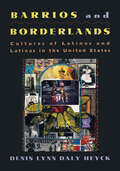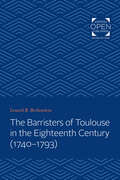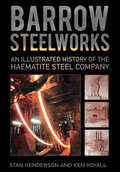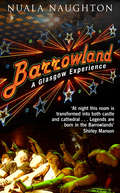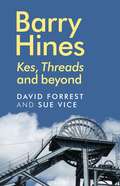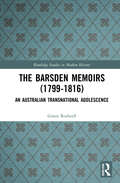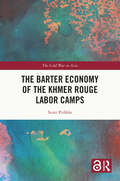- Table View
- List View
Barrelhouse Blues: Location Recording and the Early Traditions of the Blues
by Paul OliverIn the 1920s, Southern record companies ventured to cities like Dallas, Atlanta, and New Orleans, where they set up primitive recording equipment in makeshift studios. They brought in street singers, medicine show performers, pianists from the juke joints and barrelhouses. The music that circulated through Southern work camps, prison farms, and vaudeville shows would be lost to us if it hadn't been captured on location by these performers and recorders.Eminent blues historian Paul Oliver uncovers these folk traditions and the circumstances under which they were recorded, rescuing the forefathers of the blues who were lost before they even had a chance to be heard. A careful excavation of the earliest recordings of the blues by one of its foremost experts, Barrelhouse Blues expands our definition of that most American style of music.
The Barrett Rifle: Sniping and anti-materiel rifles in the War on Terror (Weapon)
by Johnny Shumate Chris McNab Alan GillilandThe Barrett M82A1 and its derivatives are among the most successful sniping rifles ever manufactured. Now entering its fourth decade of service, the short-recoil, semi-automatic system is capable of firing a devastating .50-caliber round with lethal accuracy over distances of more than 2km. Unconfirmed reports from Afghanistan in 2012 accredit the Barrett with one of history's longest ever kills at 2,815m. This is the technical history of a rifle initially developed as a sporting firearm, but which evolved into a long-range sniping rifle and a formidable military anti-materiel tool, designed to neutralize everything from enemy vehicles to parked aircraft. Adopted by snipers across the world, the Barrett rifles have seen active service in Operation Desert Storm, Iraq, and Afghanistan and have become an important addition to police, armed services, and Special Forces units alike.
The Barrett Rifle: Sniping and anti-materiel rifles in the War on Terror (Weapon)
by Johnny Shumate Chris McNab Alan GillilandThe Barrett M82A1 and its derivatives are among the most successful sniping rifles ever manufactured. Now entering its fourth decade of service, the short-recoil, semi-automatic system is capable of firing a devastating .50-caliber round with lethal accuracy over distances of more than 2km. Unconfirmed reports from Afghanistan in 2012 accredit the Barrett with one of history's longest ever kills at 2,815m. This is the technical history of a rifle initially developed as a sporting firearm, but which evolved into a long-range sniping rifle and a formidable military anti-materiel tool, designed to neutralize everything from enemy vehicles to parked aircraft. Adopted by snipers across the world, the Barrett rifles have seen active service in Operation Desert Storm, Iraq, and Afghanistan and have become an important addition to police, armed services, and Special Forces units alike.
Barricades: The War of the Streets in Revolutionary Paris, 1830-1848
by J. HarsinBetween 1830 and 1848, Paris was rocked by two successful revolutions, three failed insurrections, and seven serious assassination attempts against King Louis-Phillippe and his sons. The June Days of 1848 - the worst urban insurrection in history until that time - finally brought this period to a close. Using a wide variety of sources, including detailed court records and hundreds of depositions of witnesses and suspects, Jill Harsin examines revolutionary republicanism during the violent underground movement of the July Monarchy, and describes these events in vivid detail. The lives of 'ordinary men' are captured in their own words as Harsin illuminates the political aspirations of the working class. Harsin's original writing style and compelling discussions shed new light on the particular turbulence of this era, a period of disruption that stemmed from the contemporary working class codes of masculinity and honour.
Barricades and Banners: The Revolution of 1905 and the Transformation of Warsaw Jewry (Stanford Studies in Jewish History and Culture)
by Scott UryThis book examines the intersection of urban society and modern politics among Jews in turn of the century Warsaw, Europe's largest Jewish center at the time. By focusing on the tumultuous events surrounding the Revolution of 1905, Barricades and Banners argues that the metropolitanization of Jewish life led to a need for new forms of community and belonging, and that the ensuing search for collective and individual order gave birth to the new institutions, organizations, and practices that would define modern Jewish society and politics for the remainder of the twentieth century.
Barrie Kosky on the Contemporary Australian Stage: Affect, Post-Tragedy, Emergency (Routledge Advances in Theatre & Performance Studies)
by Charlotte FarrellThis is the first book-length study of Australian theatre productions by internationally-renowned director, Barrie Kosky. Now a prolific opera director in Europe, Barrie Kosky on the Contemporary Australian Stage accounts for the formative years of Kosky's career in Australia. This book provides in-depth engagements with select productions including The Dybbuk which Kosky directed with Gilgul theatre company in 1991, as well as King Lear (1998), The Lost Echo (2006), and Women of Troy (2008). Using affect theory as a prism through which these works are analysed, the book accounts for the director's particular engagement with – and radical departure from – classical tragedy in contemporary performance: what the book defines as Kosky's 'post-tragedies'. Theatre studies scholars and students, particularly those with interests in affect, contemporary performance, 'director's theatre', and tragedy, will benefit from Barrie Kosky on the Contemporary Australian Stage’s vivid engagement with Kosky's work: a director who has become a singular figure in opera and theatre of international critical acclaim.
Barrie Kosky on the Contemporary Australian Stage: Affect, Post-Tragedy, Emergency (Routledge Advances in Theatre & Performance Studies)
by Charlotte FarrellThis is the first book-length study of Australian theatre productions by internationally-renowned director, Barrie Kosky. Now a prolific opera director in Europe, Barrie Kosky on the Contemporary Australian Stage accounts for the formative years of Kosky's career in Australia. This book provides in-depth engagements with select productions including The Dybbuk which Kosky directed with Gilgul theatre company in 1991, as well as King Lear (1998), The Lost Echo (2006), and Women of Troy (2008). Using affect theory as a prism through which these works are analysed, the book accounts for the director's particular engagement with – and radical departure from – classical tragedy in contemporary performance: what the book defines as Kosky's 'post-tragedies'. Theatre studies scholars and students, particularly those with interests in affect, contemporary performance, 'director's theatre', and tragedy, will benefit from Barrie Kosky on the Contemporary Australian Stage’s vivid engagement with Kosky's work: a director who has become a singular figure in opera and theatre of international critical acclaim.
Barrie Kosky’s Transnational Theatres (Global Germany in Transnational Dialogues)
by James Phillips John R. SevernThis book, the first of its kind, surveys the career of the renowned Australian-German theatre and opera director Barrie Kosky. Its nine chapters provide multidisciplinary analyses of Barrie Kosky’s working practices and stage productions, from the beginning of his career in Melbourne to his current roles as Head of the Komische Oper Berlin and as a guest director in international demand. Specialists in theatre studies, opera studies, musical theatre studies, aesthetics, and arts administration offer in-depth accounts of Kosky’s unusually wide-ranging engagements with the performing arts – as a director of spoken theatre, operas, musicals, operettas, as an adaptor, a performer, a writer, and an arts manager. Further, this book includes contributions from theatre practitioners with first-hand experience of collaborating with Kosky in the 1990s, who draw on interviews with members of Gilgul, Australia’s first Jewish theatre company, to document this formative period in Kosky’s career. The book investigates the ways in which Kosky has created transnational theatres, through introducing European themes and theatre techniques to his Australian work or through bringing fresh voices to the national dialogue in Germany’s theatre landscape. An appendix contains a timeline and guide to Kosky’s productions to date.
Barriers to Democracy: The Other Side of Social Capital in Palestine and the Arab World (PDF)
by Amaney A. JamalDemocracy-building efforts from the early 1990s on have funneled billions of dollars into nongovernmental organizations across the developing world, with the U.S. administration of George W. Bush leading the charge since 2001. But are many such "civil society" initiatives fatally flawed? Focusing on the Palestinian West Bank and the Arab world, Barriers to Democracy mounts a powerful challenge to the core tenet of civil society initiatives: namely, that public participation in private associations necessarily yields the sort of civic engagement that, in turn, sustains effective democratic institutions. Such assertions tend to rely on evidence from states that are democratic to begin with. Here, Amaney Jamal investigates the role of civic associations in promoting democratic attitudes and behavioral patterns in contexts that are less than democratic. Jamal argues that, in state-centralized environments, associations can just as easily promote civic qualities vital to authoritarian citizenship--such as support for the regime in power. Thus, any assessment of the influence of associational life on civic life must take into account political contexts, including the relationships among associations, their leaders, and political institutions. Barriers to Democracy both builds on and critiques the multifaceted literature that has emerged since the mid-1990s on associational life and civil society. By critically examining associational life in the West Bank during the height of the Oslo Peace Process (1993-99), and extending her findings to Morocco, Egypt, and Jordan, Jamal provides vital new insights into a timely issue.
Barriers to Growth: English Economic Development from the Norman Conquest to Industrialisation (Palgrave Studies in Economic History)
by Eric L. JonesThis book deals sequentially with major impediments to economic growth and their slow dissolution. It is original and quite different from standard economic history, which has always sought for one prime mover of the industrial revolution after another. These supposed positive forces are usually depicted as novel and little reference is made to inertia. Instead the barriers dealt with here run, in the first section, from early misallocations of resources to nineteenth-century reforms which of their nature indicate the problems to be overcome. The second section deals with more physical impediments and shocks, such as floods and settlement fires. These too are ignored in ordinary treatments, which this book will supplement or even replace. It will be of interest to academic economic historians and practitioners of neighbouring subjects such as economists, historians, historical geographers, and of course their students.
The Barrington Papers: Vol. I
by D. Bonner-SmithSamuel Barrington (1729-1800), a son of the first Viscount Barrington, entered the Royal Navy in 1740. He was posted in 1747 and eventually was promoted to Admiral in 1787.Papers in the possession of Barrington’s collateral descendants form these two volumes and cover his naval career. They comprise order books (1747-71), a private letter book (1770-99), his journal and three bound documents relating to the Leeward Islands command (1778-79), some loose correspondence, and printed matter: the general sailing and fighting Instructions, two signal books, and instructions. None of Barrington’s public letter books survives.This includes Barrington’s negotiations at Tetuan to release British subjects held by the Barbary corsairs, and his cruising off the coast of Guinea where some Royal Navy captains had been personally profiting from commercial dealings including the transportation of slaves.Commanding the 60-gun Achilles, he served from 1757-59 off the coast of France, in 1760 under Captain the Hon John Byron destroying the fortifications of Louisbourg in North America, and in 1761 under Commodore Augustus Keppel in the operations against Belle-Île. From 1762 until the 1763 Treaty of Paris, he commanded the 74-gun Hero. From 1768, when he again took to sea, until 1778 when he received his flag, he saw service in the dispute with Spain over the Falkland Islands (1771) and in the Channel.
The Barrington Papers: Vol. I
by D. Bonner-SmithSamuel Barrington (1729-1800), a son of the first Viscount Barrington, entered the Royal Navy in 1740. He was posted in 1747 and eventually was promoted to Admiral in 1787.Papers in the possession of Barrington’s collateral descendants form these two volumes and cover his naval career. They comprise order books (1747-71), a private letter book (1770-99), his journal and three bound documents relating to the Leeward Islands command (1778-79), some loose correspondence, and printed matter: the general sailing and fighting Instructions, two signal books, and instructions. None of Barrington’s public letter books survives.This includes Barrington’s negotiations at Tetuan to release British subjects held by the Barbary corsairs, and his cruising off the coast of Guinea where some Royal Navy captains had been personally profiting from commercial dealings including the transportation of slaves.Commanding the 60-gun Achilles, he served from 1757-59 off the coast of France, in 1760 under Captain the Hon John Byron destroying the fortifications of Louisbourg in North America, and in 1761 under Commodore Augustus Keppel in the operations against Belle-Île. From 1762 until the 1763 Treaty of Paris, he commanded the 74-gun Hero. From 1768, when he again took to sea, until 1778 when he received his flag, he saw service in the dispute with Spain over the Falkland Islands (1771) and in the Channel.
Barrio America: How Latino Immigrants Saved the American City
by A. K. Sandoval-StrauszThe compelling history of how Latino immigrants revitalized the nation's cities after decades of disinvestment and white flight Thirty years ago, most people were ready to give up on American cities. We are commonly told that it was a "creative class" of young professionals who revived a moribund urban America in the 1990s and 2000s. But this stunning reversal owes much more to another, far less visible group: Latino and Latina newcomers.Award-winning historian A. K. Sandoval-Strausz reveals this history by focusing on two barrios: Chicago's Little Village and Dallas's Oak Cliff. These neighborhoods lost residents and jobs for decades before Latin American immigration turned them around beginning in the 1970s. As Sandoval-Strausz shows, Latinos made cities dynamic, stable, and safe by purchasing homes, opening businesses, and reviving street life. Barrio America uses vivid oral histories and detailed statistics to show how the great Latino migrations transformed America for the better.
Barrios and Borderlands: Cultures of Latinos and Latinas in the United States
by Denis Lynn HeyckThis unique anthology highlights the diversity of Latino cultural expressions and points out the distinctive features of the three major Latino populations: Mexican, Puerto Rican and Cuban. It is organized around six central cultural issues: family, religion, community, the arts, (im)migration and exile, and cultural identity. Each chapter focuses on a particular theme by presenting readings from a variety of genres, including short stories, poems, essays, excerpts from novels, a play, photographs, even a few songs and recipes.
Barrios and Borderlands: Cultures of Latinos and Latinas in the United States
by Denis Lynn HeyckThis unique anthology highlights the diversity of Latino cultural expressions and points out the distinctive features of the three major Latino populations: Mexican, Puerto Rican and Cuban. It is organized around six central cultural issues: family, religion, community, the arts, (im)migration and exile, and cultural identity. Each chapter focuses on a particular theme by presenting readings from a variety of genres, including short stories, poems, essays, excerpts from novels, a play, photographs, even a few songs and recipes.
The Barristers of Toulouse in the Eighteenth Century (The Johns Hopkins University Studies in Historical and Political Science #93d Ser., No. 1)
by Lenard BerlansteinFollowing the vein of French historiography, many twentieth-century scholars of the French Revolution believed that the middle class of lawyers played a crucial role in the Revolution. In The Barristers of Toulouse, Lenard Berlanstein contends with that notion in a case study examining the response of the Toulousian legal community to the French Revolution. Using tax rolls, marriage contracts, and court records as primary sources, Professor Berlanstein argues that class interests—such as a desire to preserve their status in the cultured, conservative urban elite—led many Toulousian judges and lawyers to reject the Revolution and to remain loyal to the aristocratic Parlement. In other words, those in the legal community of Toulouse conducted themselves in ways that were consistent with other members of their social and economic class. To supplement his argument, Berlanstein's integrates methods from the New Social History movement.
The Barristers of Toulouse in the Eighteenth Century (The Johns Hopkins University Studies in Historical and Political Science #93d Ser., No. 1)
by Lenard BerlansteinOriginally published in 1975. Following the vein of French historiography, many twentieth-century scholars of the French Revolution believed that the middle class of lawyers played a crucial role in the Revolution. In The Barristers of Toulouse, Lenard Berlanstein contends with that notion in a case study examining the response of the Toulousian legal community to the French Revolution. Using tax rolls, marriage contracts, and court records as primary sources, Professor Berlanstein argues that class interests—such as a desire to preserve their status in the cultured, conservative urban elite—led many Toulousian judges and lawyers to reject the Revolution and to remain loyal to the aristocratic Parlement. In other words, those in the legal community of Toulouse conducted themselves in ways that were consistent with other members of their social and economic class. To supplement his argument, Berlanstein's integrates methods from the New Social History movement.
The Barristers of Toulouse in the Eighteenth Century (The Johns Hopkins University Studies in Historical and Political Science)
by Lenard BerlansteinOriginally published in 1975. Following the vein of French historiography, many twentieth-century scholars of the French Revolution believed that the middle class of lawyers played a crucial role in the Revolution. In The Barristers of Toulouse, Lenard Berlanstein contends with that notion in a case study examining the response of the Toulousian legal community to the French Revolution. Using tax rolls, marriage contracts, and court records as primary sources, Professor Berlanstein argues that class interests—such as a desire to preserve their status in the cultured, conservative urban elite—led many Toulousian judges and lawyers to reject the Revolution and to remain loyal to the aristocratic Parlement. In other words, those in the legal community of Toulouse conducted themselves in ways that were consistent with other members of their social and economic class. To supplement his argument, Berlanstein's integrates methods from the New Social History movement.
Barrow Steelworks: An Illustrated History of the Haematite Steel Company
by Stanley Henderson K.E. RoyallDuring the second half of the nineteenth century, Barrow-in-Furness became a pioneer in iron and steel production. It went on to grow astronomically – owning collieries in three counties and ore mines in two – and became the largest integrated steelworks in north Lancashire and Cumberland and, at one time, the largest steelworks in the world. Its success was due, in part, to having the prestige of three dukes as directors, as well as to being only 2 miles away from one of the largest and richest iron ore mines in the country. Written by two former employees of the works, Barrow Steelworks chronicles the company’s past from the early empire through the inter-war and post-war years, the development of continuous casting in the 1950s, which revolutionised steelmaking, and, finally, the struggles and ultimate demise from the 1960s onwards of this once prominent industry.
Barrowland: A Glasgow Experience
by Nuala NaughtonBarrowland: A Glasgow Experience charts the amazing resurrection of the legendary rock concert venue from its humble beginnings as a popular Glasgow dance hall through its commercial decline in the 1960s and beyond until it was reinvented in the early ’80s as a concert venue that remains feted by fans and artistes alike.This book documents many of the gigs to have been held in the Barrowland, complete with reminiscences about backstage shenanigans and fascinating contributions from many of the musicians who have played there, as well as from fans who cherish memories of unforgettable concerts.Packed with interviews from the stars of popular music past and present, Barrowland: A Glasgow Experience allows readers to take a trip down memory lane and remember their favourite gigs at the world-famous venue in Glasgow’s East End.
Barry Hines: <i>Kes</i>, <i>Threads</i> and beyond
by David Forrest Sue ViceThis is the first full-length critical study of the work of Barry Hines, best know as the author of A Kestrel for a Knave
Barry Hines: <i>Kes</i>, <i>Threads</i> and beyond
by David Forrest Sue ViceBarry Hines’s novel A Kestrel for a Knave, adapted for the screen as Kes, is one of the best-known and well-loved novels of the post-war period, while his screenplay for the television drama Threads is central to a Cold War-era vision of nuclear attack. But Hines published a further eight novels and nine screenplays between the 1960s and 1990s, as well as writing eleven other works which remain unpublished and unperformed. This study examines the entirety of Hines’s work. It argues that he used a great variety of aesthetic forms to represent the lives of working-class people in Britain during the 1960s, 1970s, 1980s and into the post-industrial conclusion of the twentieth century. It also makes the case that, as well as his literary flair for poetic realism, Hines’s authorial contributions to the films of his novels show the profoundly collaborative nature of these works.
The Barsden Memoirs: An Australian Transnational Adolescence (Routledge Studies in Modern History)
by Grant RodwellCovering the life of Josephus Henry Barsden from his birth in 1799 through his childhood to 16 years of age, the Barsden memoirs describe events from a Sussex smugglers’ inn, a convict ship to the colony of New South Wales, sealing and whaling expeditions to Van Diemen’s Land, and Barsden’s participation in a Tahitian civil war. The author assesses the value of memoirs, and of these memoirs in particular to students of history in respect to the transnational paradigm. He tests the historicity and veracity of their contents, and provides an engaging exegesis and graphical supplement of its contents. Of central importance is Barsden’s account of the Battle of Fe’i Pi, which was in many respects the Pacific’s equivalent to the contemporaneous Battle of Waterloo, such was its lasting impact on Pacific geopolitics. This was no ordinary childhood, and poses many questions about a transnational adolescent’s impact on major events. A fascinating read for scholars and students of Australian, Pacific, and British Colonial History, written with academic rigour but accessible to non-specialists.
The Barsden Memoirs: An Australian Transnational Adolescence (Routledge Studies in Modern History)
by Grant RodwellCovering the life of Josephus Henry Barsden from his birth in 1799 through his childhood to 16 years of age, the Barsden memoirs describe events from a Sussex smugglers’ inn, a convict ship to the colony of New South Wales, sealing and whaling expeditions to Van Diemen’s Land, and Barsden’s participation in a Tahitian civil war. The author assesses the value of memoirs, and of these memoirs in particular to students of history in respect to the transnational paradigm. He tests the historicity and veracity of their contents, and provides an engaging exegesis and graphical supplement of its contents. Of central importance is Barsden’s account of the Battle of Fe’i Pi, which was in many respects the Pacific’s equivalent to the contemporaneous Battle of Waterloo, such was its lasting impact on Pacific geopolitics. This was no ordinary childhood, and poses many questions about a transnational adolescent’s impact on major events. A fascinating read for scholars and students of Australian, Pacific, and British Colonial History, written with academic rigour but accessible to non-specialists.
The Barter Economy of the Khmer Rouge Labor Camps (The Cold War in Asia)
by Scott PribblePribble investigates the barter economies that developed in many of the labor camps established under the Khmer Rouge in Cambodia. When the Khmer Rouge abolished currency and markets in 1975, starving Cambodians created underground exchanges in labor camps throughout the country, bartering luxury items for food and other necessities, while simultaneously undermining the regime’s ideological goals of eliminating any traces of capitalism in Democratic Kampuchea. Pribble asserts three key points about the barter economy in the Khmer Rouge labor camps. First, the underground exchanges in Democratic Kampuchea provided food and medicine for desperate people subsisting under a totalitarian regime, saving the lives of countless Cambodians. Second, bartering was the riskiest way to obtain food because it was dependent upon the discretion of two or more individuals from different social classes under the threat of violent punishment, thereby altering the social dynamics of the camps. Finally, despite the regime’s extreme efforts to eliminate foreign influence from the country and impose communist ideology on millions of citizens, basic forms of market capitalism and a demand for superfluous luxury goods persisted in labor camps throughout the country. A fascinating study of the human consequences of imposing rigid ideology, that will be of particular interest to scholars and students of political history and Southeast Asian history.
